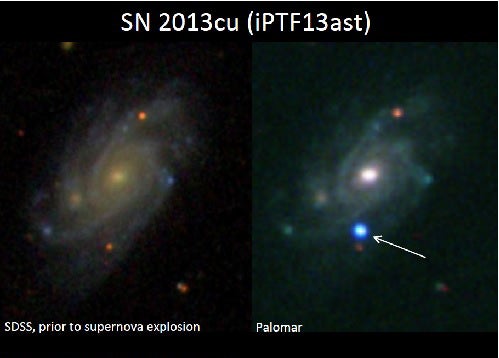Wolf-Rayet stars are notable for having strong stellar winds and being deficient in hydrogen when compared with other stars. Taken together, these two factors give Wolf-Rayet stars easily recognizable stellar signatures.
It is thought that Wolf-Rayet stars explode as type IIb, Ib, or Ic supernovae. Yet direct evidence linking these types of supernovae to their progenitor stars has heretofore been missing.
The team, led by Avishay Gal-Yam of the Weizmann Institute of Science in Israel, applied a novel observational method called flash spectroscopy to identify the likely progenitor of a type IIb supernova called SN 2013cu just over 15 hours after it exploded.
“This supernova was discovered by the Palomar 48-inch telescope in California. The on-duty PTF team member in Israel promptly sounded an alert about this supernova discovery, enabling another PTF team member to get a spectrum with the Keck Telescope before the Sun rose in Hawaii,” Kasliwal said. “The global rapid response protocol ensures the Sun never rises for the PTF team!”
When the supernova exploded, its flash ionized its immediate surroundings, giving the astronomers a direct glimpse of the progenitor star’s chemistry. This opportunity lasts only for a day before the supernova blast wave sweeps the ionization away. So it’s crucial to rapidly respond to a young supernova discovery to get the flash spectrum in the nick of time.
The observations found evidence of composition and shape that aligns with that of a nitrogen-rich Wolf-Rayet star. What’s more, the progenitor star likely experienced an increased loss of mass shortly before the explosion, which is consistent with model predictions for Wolf-Rayet explosions.
These techniques shed fresh light on the poorly understood evolution of massive stars.
Previously when looking for a pre-explosion star using the Hubble Space Telescope, astronomers could only look over a range of about 20 megaparsecs. But using these new tools they can increase that distance by a factor of five, allowing them to identify many more supernova progenitors.










